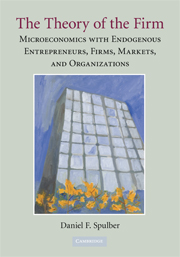 The Theory of the Firm
The Theory of the Firm Book contents
- Frontmatter
- Contents
- Preface and Acknowledgments
- Introduction
- PART I THE THEORY OF THE FIRM
- PART II THE ENTREPRENEUR IN EQUILIBRIUM
- PART III HUMAN CAPITAL, FINANCIAL CAPITAL, AND THE ORGANIZATION OF THE FIRM
- PART IV INTERMEDIATION BY THE FIRM
- PART V MARKET MAKING BY THE FIRM
- 12 Conclusion
- References
- Author Index
- Subject Index
Preface and Acknowledgments
Published online by Cambridge University Press: 05 June 2012
- Frontmatter
- Contents
- Preface and Acknowledgments
- Introduction
- PART I THE THEORY OF THE FIRM
- PART II THE ENTREPRENEUR IN EQUILIBRIUM
- PART III HUMAN CAPITAL, FINANCIAL CAPITAL, AND THE ORGANIZATION OF THE FIRM
- PART IV INTERMEDIATION BY THE FIRM
- PART V MARKET MAKING BY THE FIRM
- 12 Conclusion
- References
- Author Index
- Subject Index
Summary
This book presents a general theory of the firm. The Theory of the Firm seeks to explain (1) why firms exist, (2) how firms are established, and (3) what firms contribute to the economy. The book addresses the foundations of microeconomics by making institutions endogenous. In the models presented in the book, the following are endogenous: entrepreneurs, firms, markets, and organizations.
The general theory of the firm begins with the individual consumer. The characteristics of consumers are the theory's exogenous data. Consumers can do practically anything without firms. Consumers can produce goods and services by operating technology. Consumers can transact directly with each other through bilateral exchange. Finally, consumers can form organizations such as clubs, buyers' cooperatives, workers' cooperatives, and basic partnerships.
The firm is an economic institution that differs fundamentally from a consumer organization. This book introduces a new definition of the firm that is highly useful in developing the theory: The firm is a transaction institution whose objectives are separate from those of its owners. Consumer organizations such as clubs and basic partnerships are not firms. The objectives of consumer organizations cannot be separated from those of their owners.
Why do firms exist? The Theory of the Firm shows that firms exist only when they improve the efficiency of economic transactions. The efficiency of firms is compared to the alternative of direct exchange between consumers. Direct exchange between consumers involves search, bargaining, barter, and contracts. Direct exchange between consumers also can involve forming consumer organizations.
- Type
- Chapter
- Information
- The Theory of the FirmMicroeconomics with Endogenous Entrepreneurs, Firms, Markets, and Organizations, pp. ix - xiPublisher: Cambridge University PressPrint publication year: 2009


